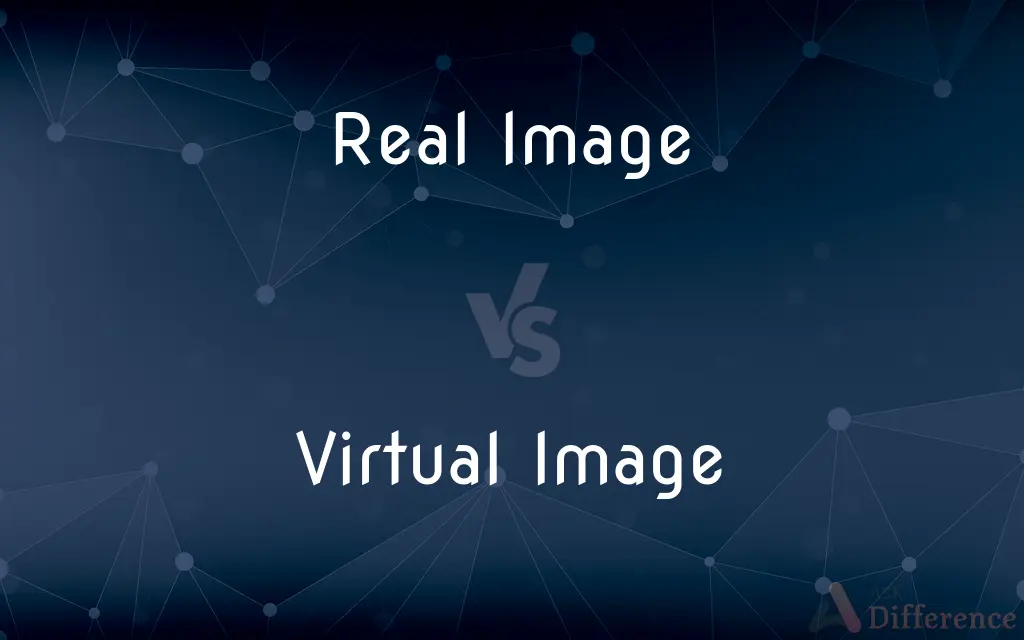Real Image vs. Virtual Image — What's the Difference?
Real Image is formed by actual convergence of light rays and can be captured on a screen, whereas Virtual Image appears from the apparent divergence of light rays and cannot be projected on a screen.

Difference Between Real Image and Virtual Image
Table of Contents
ADVERTISEMENT
Key Differences
A Real Image is a type of optical image that is formed when light rays converge after passing through a lens or mirror. It exists in a specific location and is inverted, meaning it appears upside down. Conversely, a Virtual Image is produced when light rays diverge, or appear to diverge, making them seem as though they come from a specific location when in reality, they don't.
When you capture a Real Image on a screen, it becomes visible because the light rays physically meet at a point. In contrast, a Virtual Image can't be displayed on a screen as the rays don't actually intersect; they only seem to.
A Real Image is formed on the opposite side of the lens (or mirror) from the object, and its orientation depends on the object's distance from the lens. The Virtual Image, meanwhile, typically appears on the same side as the object and remains upright in many situations.
Optical instruments such as cameras and projectors utilize Real Images to function. These devices capture or project images by manipulating converging light rays. On the other hand, magnifying glasses produce Virtual Images. When you look at an object through a magnifying glass, you're seeing a magnified, upright Virtual Image of the object.
Comparison Chart
Difference Aspect
Real Image
Virtual Image
ADVERTISEMENT
Light Ray Behavior
Converges (physically meets)
Appears to diverge (doesn't actually meet)
Projection on Screen
Can be captured or projected
Cannot be projected
Location
Formed on opposite side of lens/mirror
Appears on same side as the object
Orientation
Usually inverted
Typically upright
Common Usage
Cameras, projectors
Magnifying glasses, certain mirror configurations
Compare with Definitions
Real Image
Exists in a specific location.
Light from distant stars forms a Real Image at a telescope's focal point.
Virtual Image
Often appears deeper or behind the optical device.
The fish in the aquarium appears at a different location, creating a Virtual Image.
Real Image
Formed by converging light rays.
A camera lens creates a Real Image on the film or sensor.
Virtual Image
Doesn't result from actual light meeting.
The Virtual Image seems real to our eyes, but light rays don't truly intersect.
Real Image
Result of actual light intersection.
A convex lens focuses light to form a Real Image.
Virtual Image
Cannot be captured on a screen.
When using a magnifying glass, the magnified Virtual Image can't be projected elsewhere.
Real Image
Appears inverted in many situations.
When viewing distant objects through a converging lens, the Real Image is upside down.
Virtual Image
Typically remains upright.
The Virtual Image in a concave mirror is upright if the object is close.
Real Image
Can be projected onto a screen.
The projector displays a Real Image onto the screen for viewers.
Virtual Image
Appears due to apparent light divergence.
A flat mirror creates a Virtual Image that seems to exist behind the glass.
Common Curiosities
Is the image in a plane mirror real or virtual?
The image in a plane mirror is a Virtual Image.
Can a Real Image be displayed on a screen?
Yes, a Real Image can be captured or projected onto a screen.
Which type of image, real or virtual, is usually inverted?
The Real Image is usually inverted.
Are the images in a camera real or virtual?
The images in a camera are Real Images.
Is the Virtual Image always located behind the mirror or lens?
Generally, the Virtual Image appears to be located behind the mirror or lens.
Why can't a Virtual Image be projected?
A Virtual Image can't be projected because the light rays don't physically intersect.
Are the images formed by a magnifying glass real or virtual?
The images formed by a magnifying glass are Virtual Images.
Which is used in telescopes, real or virtual images?
Telescopes typically produce Real Images, which are then observed to create a final Virtual Image for the eye.
In which situations can a concave lens produce a Real Image?
Under typical conditions, a concave lens will produce only Virtual Images.
Do diverging lenses always form virtual images?
Typically, diverging lenses form Virtual Images.
Can Real Images be magnified?
Yes, Real Images can be magnified depending on the optical system.
Why does a Virtual Image seem to exist when it can't be captured?
A Virtual Image appears due to the apparent path of diverging light rays, even though they don't physically meet.
Share Your Discovery

Previous Comparison
Public Sector vs. Private Sector
Next Comparison
Misinterpreted vs. Misread









































